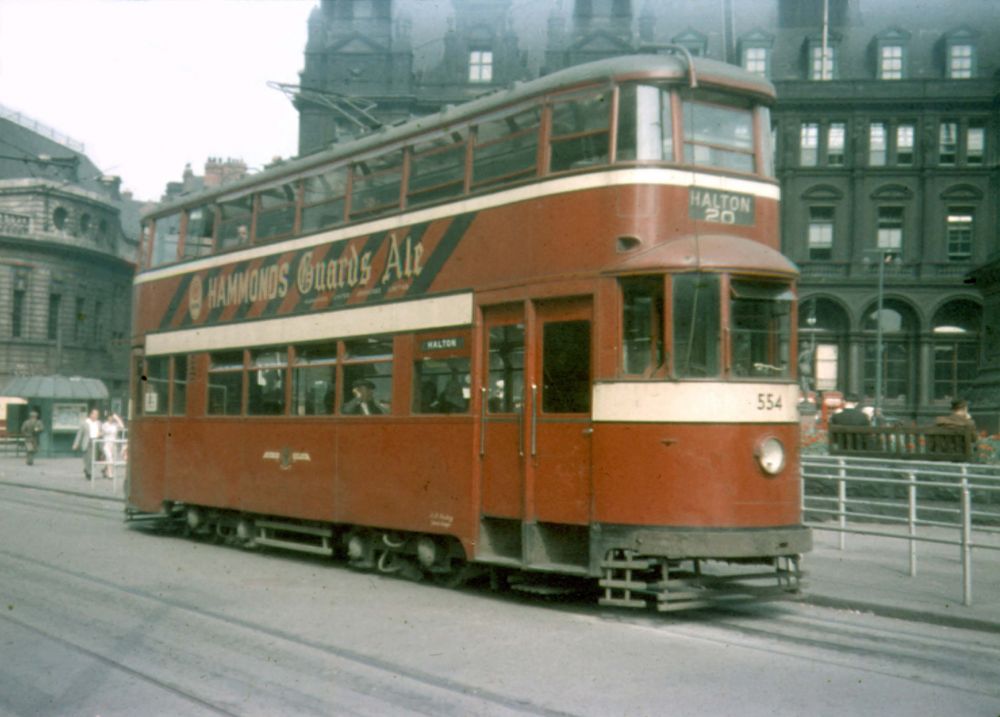
STM Library - Sister car 554 in Leeds City Sq. by A.V.C.Hamilton in 1950
- Builder
- Union Construction
- Description
- Double-deck tram
- Secondary Use
- None
- Type
- City and Suburban Streetcars
- Year
- 1931
- Retired from Service
- 1960
- Acquired by the Museum
- 1960
- Note
- No. 2085 is in Fairview carbarn. The lower level seats are missing, and the car is in need of restoration.
- Fund
- 736
London Transport 2085
From London, England
History
In 1931, the Union Construction Company of Feltham, England built 100 double-deck cars for London United Tramways and Metropolitan Electric Tramways. Car #341 was one of this class known as the “Felthams” (after their place of construction). The “Feltham” cars were the result of a complete vehicle redesign similar to the development of the PCC car in the U.S. at about the same time. No. 341 was one of 54 cars built for the MET which served London’s northern suburbs. At over 40 feet long, the “Felthams” were relatively long and had a tapering body, large entrance/exit vestibules and a low floor height. A distinctive feature was the higher floor for the operator’s cab. Rather than using overhead wires, London trams (including the MET trams) drew power from an underground conduit, similar to systems in Washington, DC and New York City. When the London Passenger Transport Board acquired the Metropolitan Electric in 1933, No. 341 became No. 2085. The car survived the World War II blitz, but the LPTB’s policy was to replace trams with trolley buses and expanded underground lines. The “Felthams” were the last new trams purchased for London. After 1938, most of LPTB’s remaining tram lines were in South London. In 1948, LPTB was nationalized and became the London Transport Executive. The last London tram ran in 1952. The tram system in Leeds acquired 90 “Felthams” from London Transport in 1950, including No. 2085, which became No. 526 at Leeds. Leeds painted its trams red and used overhead bow collectors rather than trolley poles. Leeds abandoned its trams in 1959.
In 1960, when Seashore was developing its Great World Capitals Collection, the museum turned to Leeds, which had purchased cars second-hand from London, for an example of a London tram. The museum purchased No. 526 for a price equivalent to its scrap value. The tram crossed the Atlantic aboard S.S. American Press, the same vessel which brought Blackpool No. 144 five years earlier. Unfortunately, the trip was stormy, and a large wave inflicted substantial damage to the tram which was carried on the deck because of the tram’s length. Seashore, assisted by a grant from British Overseas Airways Corp., later repaired that damage. A subsequent re-wiring project was only partly completed. Seashore has identified the tram as primarily representing its period in London. London No. 2085 is the largest of four double-deck British trams at Seashore; No. 2085 is 40 feet, 6 inches long compared with about 34 feet for the other British trams. No. 2085 is one of three “Felthams” to be preserved.
Technical Information
- Seats: 64
- Control: OK (33B)
Trucks
- Manufacturer: EMB
- Model: MT
Motor
- Number: 2
- Manufacturer: BTH
- Model: 509P1
Weight and Dimensions
- Length: 40’ 6.00"
- Width: 7’ 2.00"
- Height: 16’
- Weight: 40992 lbs.
© 1998 - 2026 New England Electric Railway Historical Society. All Rights Reserved.